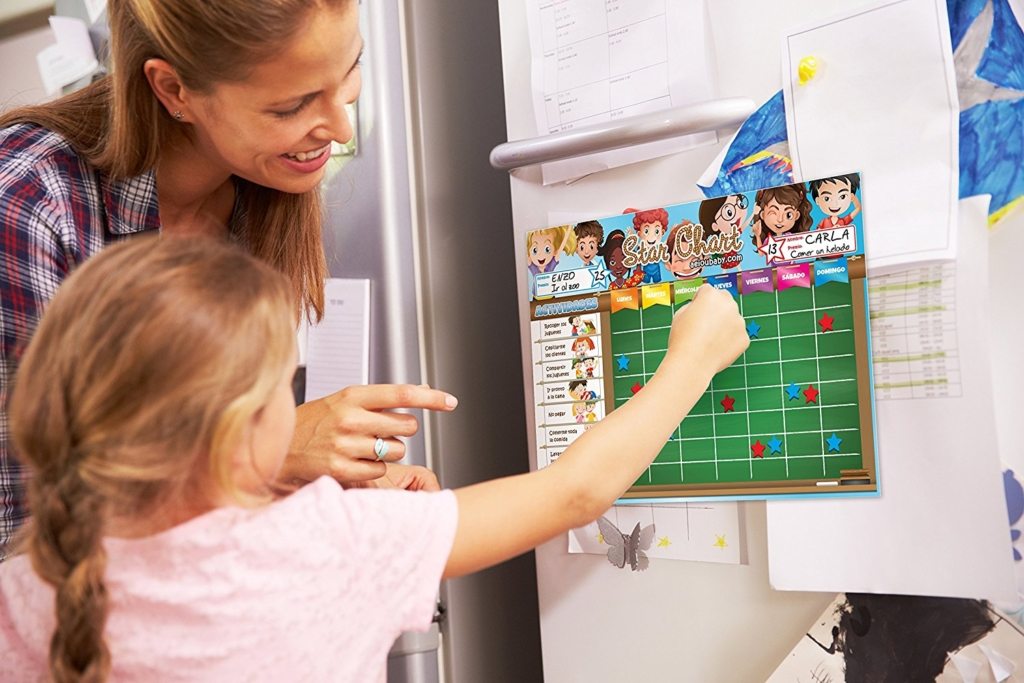The results are in, and too much screen time can have detrimental effects to your child’s brain. Yikes! This is not a small issue. We have worked ourselves into another major pickle one push notification at a time. Screens are rewarding, both visually and in a tactile manner, devices are designed to ding all of the pleasure centers of the brain. And those games are like candy. If you’re like us you’ve pictured it… the day you just yank that $800 device from your child’s hands and chuck it out the window. But then you see your phone light up and realize that you may have a bit of a screen addiction yourself. Well, if that’s the case (managing screen time is a struggle) just hear us out. Too much screen time “damages the brain’s gray and white matter, alters cerebral cortex thickness, and impairs cognitive function” according to Psychology Today. Pretty scary findings for one of the most common consumer goods. The good news is that reducing screen time doesn’t have to be a battle, and the great news is that it’s going to take a lot of hard work. Yes, you read that part right. We’re not here to make it seem as though “there’s an app for that.” (Although yes, there is an app for that.) Because there is so much more to reducing screen time than setting a timer and saying “times up, now do your homework!” Instead of simply listing off a number of apps to help you reduce screen time, we want to help you find a way to break the pattern, and find a balance that leads to a happier healthier brain, and consequently a happier healthier child!
1. Find Something More Valuable
Here’s why you should find something more valuable than the screen: you want no screen time to be engaging too. So what is more valuable than time on their phone? A trip for some ice cream of a scavenger hunt in the woods could be just the thing. For many of you, the real answer will be nothing. Nothing is more valuable than screen time as these days kids socialize on their screens, their favorite games are on their screens, and even some of their favorite hobbies require their screens. We understand, but that doesn’t mean there isn’t something that can become more valuable over time. What about money? Giving up their screen is worth rewarding. Over time that money could add up to something more valuable- a trade in. What happens is that saying “no” to screens becomes worthwhile. It’s not a punishment. It’s actually a reward. From there you can start to build on that reward. Take longer breaks from screens even whole weekends and devote those down times to engage in other exciting hobbies. Before you know it, you’ll not only have a grip on screen time, your son and daughter will have rekindled or discovered brand new hobbies and interests. See, we said this was hard work, but it will be worth it!
2. Play Prompts

Sometimes all it takes is a suggestion to do something novel instead of screen time. This can work wonders for all ages, but certainly has some promise for young children. We know that there are technologies for babies, and are certain we have seen toddlers with Smartphones. playHOORAY! offers low cost ready-made play activities for toddlers. This is great for parents who are exhausted, at home with the toddler, and running out of steam. It is entirely normal to feel completely done, and just say “Ok Johnny, you can watch some T.V.” A few hours of napping later and “some” TV just became the entire afternoon. That’s why Play Prompts are so exciting, and no- it’s not cheating. We like that they don’t cost very much, are versatile, already to go, and can easily fill up an afternoon without too much exertion. Everyone wins with play time- it’s how children learn best, you don’t have to feel the guilt of screen time, and with a ready-made affordable Play Prompt you aren’t spending precious hours creating that engaging activity yourself.
3. Use A Visual Rewards System on the Refrigerator

We love to track our progress with apps. There are so many things to track- our goals, our moods, our life! We like moving this system off of the screen back to a chart that you can hang on your refrigerator or somewhere prominent. Explain to your children that the goal is to reduce screen time, and that the outcome will be rewarding. Create a rewards system like a star chart or another symbol that matches their interests to help them visualize their progress. Set an achievable goal. If that means just 20 minutes less at first, then great! Start there, and track it. Did your daughter reach for her paints and keep the tablet off for an extra 20 minutes ? Let her put a star on her chart. At the end of the week what does she earn? Maybe it’s a manicure with Mom or a trip to that bounce center in town with Dad- what she didn’t earn is extra screen time, you don’t want her to associate screen time as the reward. Over time you can increase the time interval. Pretty soon you can skip entire afternoons and evenings. If you notice your daughter is taking extra steps herself to reduce her time in front of a screen, then you can surprise her with a reward mid-week. Again, time away from the screen becomes fun, the process is visualized, and may even feel like a game. Self-monitoring is an executive function and a skill that she will benefit from in other areas of her life as well.
4. Limit Your Own Screen Time

Modelling what you want to see is an essential aspect of parenting. So, set the example. You not only set the example, you participate in their challenge so you have to work together. Suddenly this becomes a family affair, and there are boundless opportunities to build in quality family time. You may not realize how much time you spend on your screen each day. A recent study on screen time elucidated in a piece on NPR demonstrated that on average parents were spending over 9 hours per day on their screens. When factoring in 8 hours of sleep and 9 hours and 45 minutes of screen time, that leaves you with a whooping 6 hours and 15 minutes of “real life.” Could this be one of the reasons too much screen time leads to cognitive impairment? What should you do without the screens? The temptation may be to head straight to the books, but for some after that many hours on a screen, a book could feel like a punishment. This won’t be true of all children, but if reading paper materials is a real drag try something else first. Take trips together, find crafts the family enjoys, get out and exercise more, and play board games where everyone can participate. We play a lot of Munchkin an engaging board game that encourages talk, strategy, and monster fights.
5. Reduce Evening Activity

If you need to pick a time of day to reduce screen time, all times are great opportunities for family time, but 4 hours before bed is a really healthy time to switch off. Why bedtime? If you experience sleep issues, one of the first things your doctor will talk to you about its “sleep hygiene” and will include switching off technology as one of them. The blue light emitted by screen on cell phones, tablets, computer and televisions actually inhibit the production of melatonin. We need melatonin to help us stay in a healthy sleep pattern or circadian rhythm. If you’re online, your brain is active. Social media apps like Facebook and Twitter are constantly sending your brain the message that something exciting is taking place- and those push notifications actually push a little sympathetic nervous system button.Unless you’re sleeping up in a tree to avoid bears, you really don’t need to trigger your fight, flight, and freeze response just before bed. In fact, you need to do the opposite- rest and repair. Your body is already designed to make intelligent decisions about when to remain alert, and when to remain calm. Using technology at night is one way to counteract your body’s natural patterns. A child who struggles with sleep, struggles in school, and struggles to communicate and, can lead to obesity. So switch off at night!
Apps to Reduce Screen Time
6. Screen Time
ScreenTime is a parental control app for Android and iOS. You can set a time limit on all devices, create schedule, use rewards visualization, pause your child’s device as well as monitor search history. The cost for this app is just $4 per month.
7. unGlue
unGlue is a great way to differentiate screen time across members of your family. While one child may have a goal of reducing screen time by 20 minutes, another may be working towards 2 hours. Not every child will be the same, and this app accounts of that. This app will also block specific sites. It is available on both iOS and Android.
8. getScreen
getScreen is a comprehensive devicethat manages all devices including tablets computers, chromebooks, phones and TV. It is available for iOS, Android, Roku, and more. This device remotely turns off game consoles and TV, and displays custom messages. It cost about $100.
9. Moment
Moment is a great iOS app that we absolutely love. Have you ever wanted to know exactly how much time you and your family spends on their iPhones? Well now you can with moment. This a great way to collect baseline data to help you determine the end goal, and the initial time interval.
10. bSocial
bSocial is an iOS app that offers screen time based off of the amount of time spent away from the screen. While we don’t often recommend using screen time as the big pay off or the big reward, we like that this app focuses primarily on time away from the screen. But really if your child is spending more time away from their screen, then we love it!
Resources Guide
Not convinced that reducing screen time is going to make that much of an impact? We recommend taking a look through our resource guide for more information on how screen time affects infants to adolescents.
- Set Limits and Move Your Body
- The Right Amount of Screen Time
- The prevalence of Cyberstalking and Digital Abuse
- Social Media Behavior in Parents
- Screens Keep Us Awake
- Managing Media
